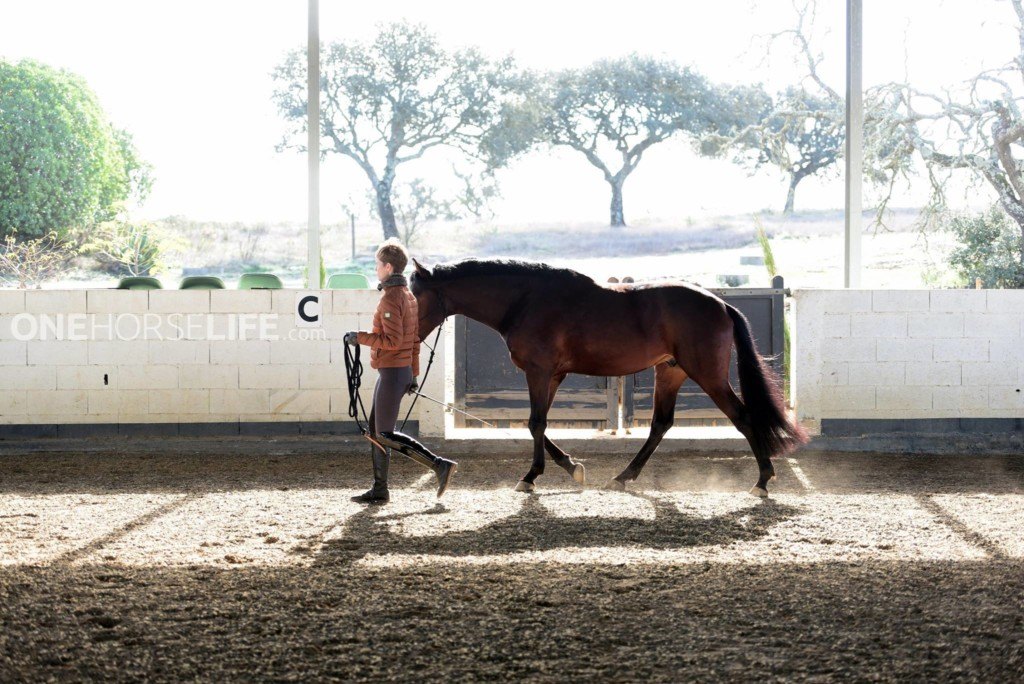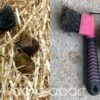Last week we had another major breakthrough on our journey with Falcao. Falcao is a 7yo Lusitano stallion who joined OHL for trainings on the last day of 2017. Today, is the 10th day since he came, and I am journaling here his journey for you.
FALCAO IS NOW:
– able to trot without speeding up and becoming more and more excited with every single step,
– able to trot on a simple halter, and not on the bit (I assume this is how he was worked before, since he doesn’t know the shape of the circle, and was pulling with a big force to the outside of the circle)
– able to stay Calm, listening to me and connected to me throughout the duration of the training, and most importantly,
– FALCAO IS ABLE TO LOWER HIS HEAD IN TROT
Wait. Isn’t it something normal that every horse should be able to do and perform? No. It can be something very difficult for many horses whose fascia is tensed.
Fascia is a collagen joining tissue of the body. Fascia keeps all the organs at the given place, and connects all the pieces of the body, and is more like a 3D spider web that goes in many dimensions through the body, than like a thin layer on top of the given pieces of the muscles. The role of fascia in the body is now researched by the top sports medicine scientists and new discoveries about it’s role are coming every single week.
We can illustrate the situation when the FASCIA IS TENSED with an example of a pillow & pillow-case. When you somehow put the too big pillow in a too-small the pillow-case, the pillow itself becomes instantly very stiff and feels hard when we touch it. There is no space to re-adjust the pillow-stuffing within the pillow-case, because the case holds it so strongly and with such a tension that any movement feels more like tearing apart than moving something within.
However, when you change the pillow-case size, and put the same stuffing into a bigger pillow-case, the pillow suddenly appears as soft, and the stuffing is more mobile within the pillow-case; you can easily adjust it, move it, even stretch it and make it comfortable for yourself.
OK. How this applies to our case with Falcao?
When he came to me, his body was very tensed, up to the point where the skin was so hardly attached to the body that one could hardly grab it. It was neither sliding nor rolling on the body. The muscles felt like a hard play-doh in plastic bags. This told me much about how stressed he was, and how much his fascia was tensed due to previous trending/environment impact.
The first reaction from a trainer in such a situation, could be to start stretching the horse, and gradually provide more mobility into the body and tissues. When the trainer sees that the horse wants but somehow cannot lower his head, there is a very big temptation to “help him” with the gadgets. This is a very big mistake.
Recent discoveries from the field of sports medicine show that when the body is being stretched NOTHING IS REALLY LENGTHENING ! neither the ligaments nor the muscles.
So how the bigger range of the movement appears?
THANKS TO CALMNESS & HYDRATION ‼️
Importance of the hydration in sport is obvious. Everyone knows that a top athlete has to drink lots of fluids and supplement electrolytes prior and past the trainings. Top tennis players are weighted before and after the trainings, and get behavioral rewards for keeping their weight same throughout the workout, before it and past it.
Does it mean that to lengthen the horse’s tissues is enough to make sure he drinks a lot?
Not really when it comes to fascia.
Newest discoveries, again popularized by the last Olympic Games, say that what we see as “stretching” is in fact ABILITY OF THE LAYERS OF FASCIA TO SLIDE ONE ON ANOTHER.
This ultimately is why possibility of UNRESTRAINED AND CONTINUOUS MOVEMENT for horses is so important. When the horse is kept in the box (box rest, or like stallions who spend most of their lives in boxes) the ability of the layers of fascia to slide one on top of another is being compromised. It’s literally as if you put glue or very sticky honey between the layers.
When you hydrate the body, the fluid between the layers of the fascia can allow better slide for the fascia layers.
“Stickiness” of the fascia is also caused by stress. When the body tenses, the ability of every tissue of the body to HOLD WATER is being compromised significantly.
In our case, what changed so dramatically Falcao’s ability to lengthen the frame was not the usage of gadgets to mechanically caused desired position, neither positive training methods.
I saw him really wanting to take the head down, but the body was kind of “holding him”.
WHAT WAS MY STRATEGY:
– MOVEMENT! You cannot take your stallion only once a day for a training and expect great flexibility from his body.
– CALMNESS: we walked until he started showing Calming Signals and more relaxation within the body, and only then we gradually moved to trot and only for few steps at a time,
– RELAXATION: Twice a day I was giving Falcao BodyMarc Duo treatment.
– CONNECTION: I always moved within his comfort zone, and was not exceeding it unless he showed by himself that he is ready for it by presenting the given behaviors for himself.
From this point we can start building up his muscles, because the body moves in the relaxed way, using it’s natural balance.


